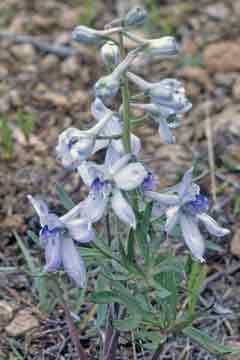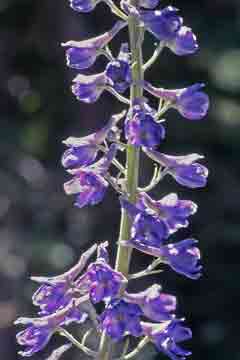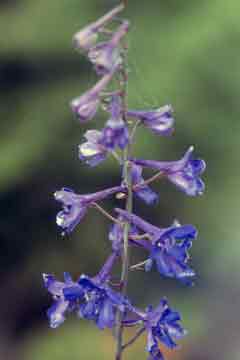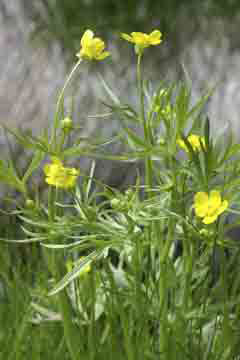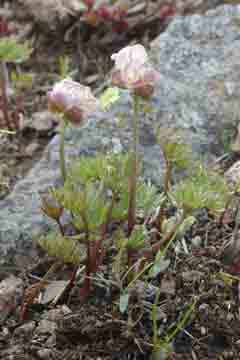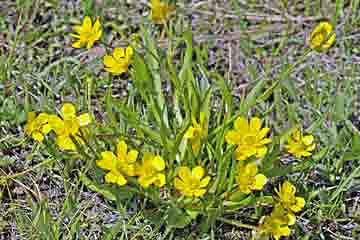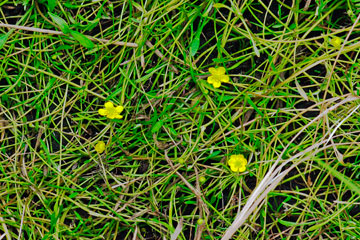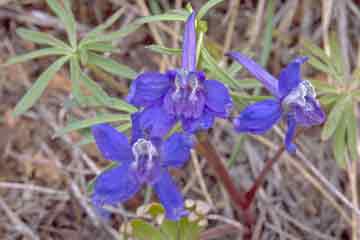 |
Larkspurs, Delphinium spp. Delphinium, from the Greek means “little dolphin,” apparently from the shape of a now unknown European flower. It was used by Dioscorides (c. 40-90 AD), a Greek physician whose De materia medica (c. 77 AD) remained a standard medical and botanical text for more than 1,600 years. Larkspurs are a prime example of “my wildflower; your weed.” They decorate our mountainsides with showy splotches of purple, yet they poison cattle. Their flowers consist of five outer sepals that enclose much smaller petals. The upper sepal forms the distinctive spur that gave us the name "larkspur." Upland larkspur, Delphinium nuttallianum Pritz. (left, right) is often found on over-grazed land. The plants are usually only six to ten inches high, and flower early in the spring on dry ground, often surrounded by sagebrush. The plant grows as high as treeline. Its flower color varies from deep blue or purple, through an attractive soft blue-gray (right), to white. Regardless of the flower color, blue marking is always retained on the upper petals. |
|
|
Slim larkspur, Delphinium depauperatum Nutt. (left) is one of our common larkspurs (the species name, depauperatum means “impoverished,” although it doesn’t seem to fit the plant). It may grow as a solitary tall plant, or as a cluster, in meadows and in the shade of open woods.The plant can be identified by its three-lobed, basal leaves (not shown), and by tiny bracts (leaflets) on each of the flower stems. It blooms later than the upland larkspur and is much taller. Tower larkspur, Delphinium glaucum S. Watson (right), is usually classified as Delphinium occidentale (S. Watson) S. Watson. Present thinking is that Delphinium occidentale is a hybrid between this plant and Delphinium barbeyi (Huth) Huth (not shown). It is an impressive, often several-stemmed, mountain plant that may be six feet tall or more tall. It grows along streambanks where its many bright blue to purple flowers stand out against surrounding green foliage and make it easy to identify. By way of confirmation, the stems below the flowering portion are “fistulous” (hollow), and its large compound leaves are palmate, made up (usually) of five, three-lobed leaflets. The plant is also known as the “dunce-cap” delphinium for its long-spurred flowers. |
|
|
Buttercups, Ranunculus spp. Most buttercups are easy to identify generically, but species classification—based in large part on the appearance of their fruit (“achenes”)—can be difficult. A few easily identified species are shown here. There are other plants with similar yellow flowers--notably potentillas (rose family)--but remember; buttercups usually bloom early, in wet places Sharp-leaf buttercup, Ranunculus acriformis A. Gray (left) grows at mid- to higher elevations in our mountains, often seen in moist meadows and along streambanks. The plants may be identified by their long-stemmed three-parted compound leaves. Each of the leaflets is further divided into (usually) three slim, pointed lobes. The flowers mostly have five petals, but there are often more. The species name, acriformis, mirrors the common name, "sharp-leaf." Pink buttercup, Ranunculus andersonii A. Gray (right) is a plant that few would recognize as a buttercup at first glance. Its leaves are deeply lobed into frilly leaflets; this, and the unusual pink to reddish-brown color of its petals set it apart from other species. Pink buttercups bloom very early in the spring on well-drained gravelly ground. It was first collected by Dr. C. L. Anderson near Carson City, Nevada, in 1866, and named for the doctor by Asa Gray, professor of botany at Harvard University. |
|
|
Blue mountain buttercup, Ranunculus
oresterus L. D. Benson
(left) grows from the Blue Mountains of northeastern Oregon,
eastward into Idaho and across the central part of the state to Elmore
County. It blooms, often in large numbers, in moist mountain meadows at lower
elevations. The plants are easily distinguished from other buttercups by
their clustered appearance, each having five or more flowers, and by their
linear, grass-like leaves. The plants are described as having five sepals
and petals to a flower, but as can be seen in the illustration, there are
often more.
Plantain-leaved buttercup, Ranunculus alismifolius Geyer ex Benth. (right) appears soon after snow melt at higher elevations. It is identified by the unusual appearance of its flowers with five very small petals, and by round leaves that bear some resemblance to those of water-plantain (Alisma spp., Alismataceae), explaining both common and species names. Several varieties are recognized, identified by the number and size of the petals, by the shape of the leaves, etc. |
 |
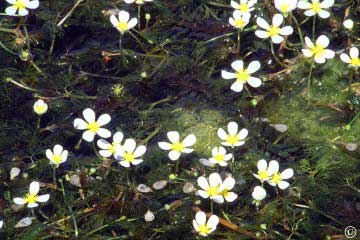 |
White water buttercup, Ranunculus
aquatilis L. (left), also
“white water-crowfoot,” has yellow-centered, mostly five-petaled,
white flowers whose stalks extend above slow-moving water. Three-parted leaves
form when the plants are grown out of water, but when submerged the leaves
divide to form soft, hairlike leaflets that offer little resistance to the
current. The plants are good indicators of how much dissolved organic material
is present—a pond covered with a white blanket of these little plants
suggests serious pollution. The water buttercup grows in most states and
provinces and in Eurasia.
Subalpine buttercup, Ranunculus eschscholtzii Schlecht. (right) The subalpine, or Eschscholtz’s, buttercup is a high altitude species, found throughout our western mountains, and north to Alaska. It blooms in moist declivities that catch the snowmelt, often tunneling up through the receding edges of snow fields. The plant has a thick stem and three- parted leaves. The lobes divide into three segments (not yet developed here). Its flowers have (mostly) five petals and a calyx made up of as many sepals. Johan Friedrich Eschscholtz (1793–1831) was an Estonian who accompanied Kotzebue’s around-the-world-expedition (1815–1818). |
|
 |
Sage buttercup, Ranunculus
glaberrimus Hook.
(left) is one of the most common and recognizable of our
buttercups because its bright yellow petals have a shiny, waxy gloss;
glaberrimus means “smoothest.” It grows from low to high
elevations as an early spring-blooming plant that favors open sagebrush slopes.
The oval leaves of the sage buttercup are often “entire,” i.e.,
they are smooth edged, without lobes or leaflets (although some plants also
have three-parted compound leaves). Each plant usually has several flowers
and most have five petals, although the number varies.
Hillside buttercup, Ranunculus jovis A. Nelson (right). The hillside, or Jove’s buttercup grows on open montane to subalpine sagebrush covered slopes, blooming soon after snowmelt. Its petals are not prominent and some flowers seem not to have any at all. Short-stemmed, lanceolate, three-parted leaves help to identify the plant. We have not been able to learn to what or to whom jovis refers—presumably to the Roman god, but why? |
 |
|
Creeping buttercup, Ranunculus flammula L. (left) is a moisture dependent plant that grows on mudflats, and in backwaters, from low elevations to high mountains. It is identified by its smaller-than-usual buttercup-like flowers and by long tangled stems that can take root at nodal intervals. The plant grows in all but our southern states, in Alaska, all the Canadian provinces, Greenland and Eurasia. The species name, flammula, from the Latin, means "little flame." |
|
Home | Next | Previous | Index | Purchase book
